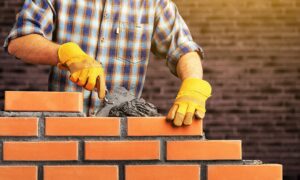Charleston Masonry construct and repair walls, partitions, arches, sewers, and other structures using masonry materials like brick, concrete, cinder, and stone. They bind these materials together with mortar according to plans and specifications.
They work with other construction site professionals and must have a strong work ethic. They must also be able to adapt to changing circumstances and adjust their techniques accordingly.

Brick masons construct and repair structures using bricks, concrete blocks, and other types of masonry. They review blueprints and plans to understand the layout and specifications of the project, then lay bricks or block building materials according to those designs. They also mix and spread mortar and other substances to bind these components. In addition, they are responsible for repairing and restoring existing masonry structures. They collaborate with other construction professionals, such as engineers and architects, to ensure their work complies with the project’s specifications.
Job duties include:
- Laying and repairing bricks.
- Preparing and cleaning work areas.
- Ensuring all tools and equipment function properly.
They are also responsible for estimating the required materials for a project. They must also have the physical strength and stamina to perform taxing tasks, such as lifting heavy loads or working at heights. In addition, brick masons must be able to follow all safety protocols while working on construction sites.
Typical daily duties of a brick mason include:
- Reviewing blueprints to understand the layout and specifications of the project.
- Measuring and cutting bricks to size.
- Mixing and spreading mortar.
They may also work with various tools and machines to construct walls, foundations, sidewalks, and other structures. Brick masons must be able to create precise patterns and layouts and have good spatial awareness to visualize their designs accurately.
Some brick masons specialize in a particular area of the profession. For example, some are experts in the construction of refractory brickwork used in industrial furnaces and kilns. Others are skilled in paving bricks, which are used to create driveways and walkways. Some brick masons are even able to restore historic brickwork and other structures.
Those interested in becoming brick masons can attend technical colleges or apprenticeship programs to learn the trade. These programs typically last for about three to four years and prepare students for a career in masonry. High school graduates who wish to become masons can also apply for on-the-job training, which is an option that can be less expensive than attending a four-year university.
To become a brick mason, you must have a high school diploma or GED certificate. You can also take courses at a vocational school to get the necessary training. In addition to this, it’s important to have physical strength and stamina because the work can be very demanding. You may need to climb ladders or scaffolding and be on your feet for long periods.
Most brick masons learn the trade through a formal apprenticeship program. These programs typically last three to four years and combine on-the-job training with classroom instruction. Labor unions and contractor associations offer them. Apprentices are paid while learning the craft and can often earn a journeyman certification after meeting certain requirements.
Masons can also learn the trade independently, though this is not recommended for people who want to succeed. Those who know the trade on their own usually start as helpers or laborers, and then they can learn from experienced craftworkers how to mix mortar, lay bricks, set stones, and repair masonry structures. In addition, they should know how to protect homes from humidity or water ingress and understand occupational health and safety regulations.
A brick mason should also be proficient in setting up scaffolding and safety procedures. They must also be able to calculate distances between reference points and know how to set up a level and plumb bob. Additionally, they must be able to break and cut tiles, blocks, and bricks to the correct size using hand and power tools.
In addition to these skills, a brick mason should be familiar with the different materials used in masonry. They should also have the ability to read blueprints and mechanical drawings. They should also be able to operate heavy machinery, such as dump trucks and backhoes, on construction sites. Finally, they should be familiar with the latest technology in masonry. A self-employed mason should have a business license, while those contracting with companies must have a contractor’s license.
Brickmasons work in various settings, including construction sites, office buildings, warehouses, and residential homes. They must be comfortable working at heights and are usually required to wear protective gear like hard hats and steel-toed boots. They also use tools and equipment like trowels, levels, plumb lines, and power saws. Masons must be able to mix mortar with the proper consistency and apply it properly to bricks, stones, or blocks. They may also be responsible for cutting and shaping these materials to fit specific angles, curves, or openings in the structure.
Brick masons often collaborate with other professionals, such as architects and engineers, to ensure their brickwork is consistent with the project’s design. They must be able to read blueprints and follow detailed specifications to meet the requirements of each job. They may also be responsible for repairing and restoring existing brick structures.
Masons typically learn their trade through apprenticeship programs many local unions and contractors offer. These programs allow aspiring masons to learn construction basics, such as blueprint reading and mathematics for measurement, and build skills on the job under the guidance of an experienced mason. Many technical schools also offer programs in masonry. After completing an apprenticeship program, masons are considered journey workers and can perform construction work independently.
The average workweek for a brick mason is less than 40 hours, and they may be expected to work evenings or weekends. These hours may be increased during peak periods of construction activity. They must also be able to work in extreme weather conditions and be comfortable working on scaffolding. Masons must also maintain a clean work area and adhere to safety protocols.
Despite the physical demands of this career, many people find brickmason jobs rewarding. This is because they provide a sense of accomplishment and are a highly skilled craft. In addition, they are well-paid and relatively stable. They are ideal for individuals who prefer tactile, physical, and athletic tasks. To be successful in this field, you need to have a strong desire to learn and develop new skills.
To build or repair certain structures, brick masons work with bricks, stones, concrete blocks, and other materials. They may work in various settings, including residential areas, commercial complexes, industrial facilities, and historic restoration projects. Depending on the type of project, brick masons must be able to work under tight deadlines and adhere to construction schedules.
The responsibilities of a brick mason include preparing the work area, mixing mortar, and applying it to various surfaces. Masons also need to be able to use power tools and handle heavy materials. In addition, they need to climb ladders or scaffolding and have good physical stamina.
Some brick masons specialize in specialized types of brickwork, such as refractory bricks used in high-temperature environments like kilns and furnaces. Others focus on decorative brickwork, creating unique patterns and designs that enhance the aesthetics of a building. Some masons also specialize in paving bricks, which are used to create walkways, patios, and courtyards.
Another important aspect of a brick mason’s job is collaborating with other construction professionals to ensure the brickwork meets project specifications. This requires effective communication and teamwork skills. Moreover, masons must be able to identify and resolve issues that may arise during a project.
Several factors determine the salary of a brick mason. Some of these factors include education, experience, and skill level. Generally, masons with more experience are paid higher wages than those with less experience. In addition, the job’s location can also affect the salary.
Generally, masons make a median annual salary of $51,750. This is higher than the average salary for similar jobs across the country. In addition, the pay of a brickmason is influenced by the cost of living in the city or region.


